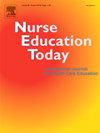实习护生死亡教育需求及其与安宁疗护态度的关系分析
IF 4.2
2区 医学
Q1 EDUCATION, SCIENTIFIC DISCIPLINES
引用次数: 0
摘要
护生死亡教育作为未来安宁疗护发展的重要力量,在提供安宁疗护服务中扮演著重要的角色。然而,目前的研究忽略了死亡教育需求在个体间的异质性,很少有研究探讨死亡教育需求的影响因素及其与护理实习生临终关怀态度的关系。目的通过潜在特征分析(LPA),发现中国护理实习生死亡教育需求的独特性,探讨死亡教育需求的影响因素及其与护理实习生临终关怀态度的关系。DesignCross-sectional调查。中国山东省某三级医院。研究对象为来自5所医科大学的实习护士225名。方法采用潜在特征分析(latent profile analysis, LPA)建立中国护理实习生死亡教育需求的潜在特征模型。基于不同的潜在特征,采用二元logistic回归分析来检验高死亡教育需求的预测因子。结果实习护士死亡教育需求可划分为“低水平需求-高死亡观”组(26.2%)和“高水平需求”组(73.8%)。以低层次需求-高层次死亡观为参照,二元logistic回归分析显示,受教育程度、丧亲经历、临终关怀偶发机会和临终关怀态度是护理实习生死亡教育需求的显著预测因子。结论中国护理实习生的死亡教育需求具有明显的特征。护生受教育程度较高、有丧亲经历、有机会照顾临终者、对安宁疗护持积极态度者,更可能属于“高需求”群组。这些发现为未来死亡教育培训模式的发展提供了有价值的见解。本文章由计算机程序翻译,如有差异,请以英文原文为准。
Latent profile analysis of death education needs and its relationship with hospice attitude among intern nursing students
Background
As a critical force for the future development of hospice care, death education for nursing students plays an essential role in the provision of hospice care services. However, current research has overlooked the heterogeneity of death education needs among individuals, and few studies have explored the influencing factors of death education needs and its relationship with hospice attitude of nursing interns.
Objective
A latent profile analysis (LPA) was conducted to identify the unique characteristics of death education needs among nursing interns in China and to explore the influencing factors of death education needs and its relationship with hospice attitude of nursing interns.
Design
Cross-sectional survey.
Settings
A tertiary hospital in Shandong Province, China.
Participants
The sample consisted of nursing interns (N = 225) from five medical universities.
Methods
Latent profile analysis (LPA) was used to establish a latent profile model for death education needs among nursing interns in China. Binary logistic regression analysis was then performed to examine the predictors of high death education needs based on the different latent profiles.
Results
Nursing interns' death education needs could be categorized into two latent groups: a “Low-level needs-higher views of death” group (26.2 %) and a “High-level needs” group (73.8 %). Binary logistic regression analysis, with the Low-level needs-higher views of death as the reference, revealed that educational level, experience of bereavement, occasional opportunities to care for the dying, and attitudes toward hospice care were significant predictors of nursing interns' death education needs.
Conclusions
Death education needs among nursing interns in China exhibit distinct profiling characteristics. Nursing interns with higher educational levels, experience of bereavement, opportunities to care for the dying, and positive attitudes toward hospice care are more likely to fall into the “High-level needs” group. These findings provide valuable insights for the development of future death education training models.
求助全文
通过发布文献求助,成功后即可免费获取论文全文。
去求助
来源期刊

Nurse Education Today
医学-护理
CiteScore
6.90
自引率
12.80%
发文量
349
审稿时长
58 days
期刊介绍:
Nurse Education Today is the leading international journal providing a forum for the publication of high quality original research, review and debate in the discussion of nursing, midwifery and interprofessional health care education, publishing papers which contribute to the advancement of educational theory and pedagogy that support the evidence-based practice for educationalists worldwide. The journal stimulates and values critical scholarly debate on issues that have strategic relevance for leaders of health care education.
The journal publishes the highest quality scholarly contributions reflecting the diversity of people, health and education systems worldwide, by publishing research that employs rigorous methodology as well as by publishing papers that highlight the theoretical underpinnings of education and systems globally. The journal will publish papers that show depth, rigour, originality and high standards of presentation, in particular, work that is original, analytical and constructively critical of both previous work and current initiatives.
Authors are invited to submit original research, systematic and scholarly reviews, and critical papers which will stimulate debate on research, policy, theory or philosophy of nursing and related health care education, and which will meet and develop the journal''s high academic and ethical standards.
 求助内容:
求助内容: 应助结果提醒方式:
应助结果提醒方式:


